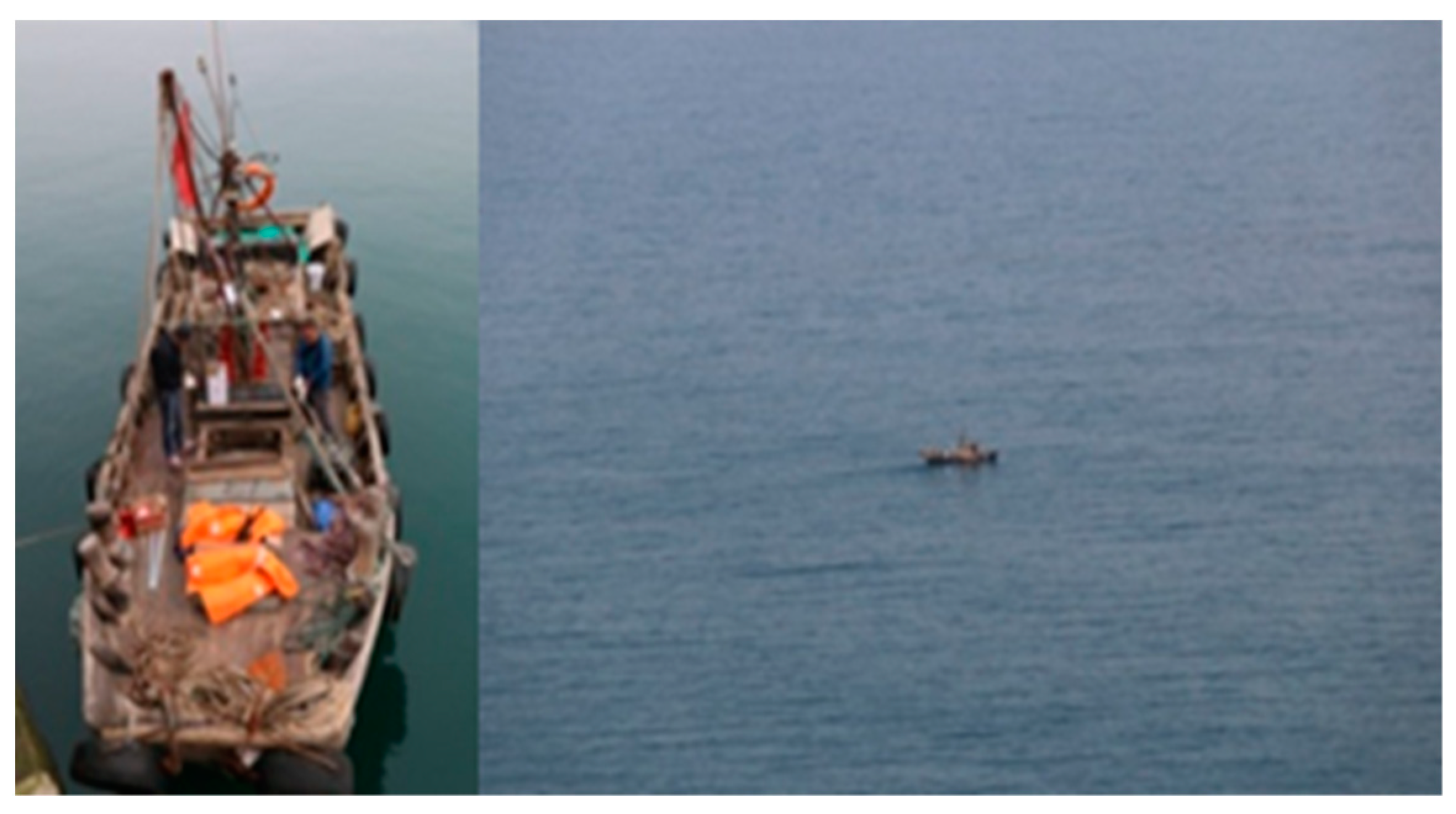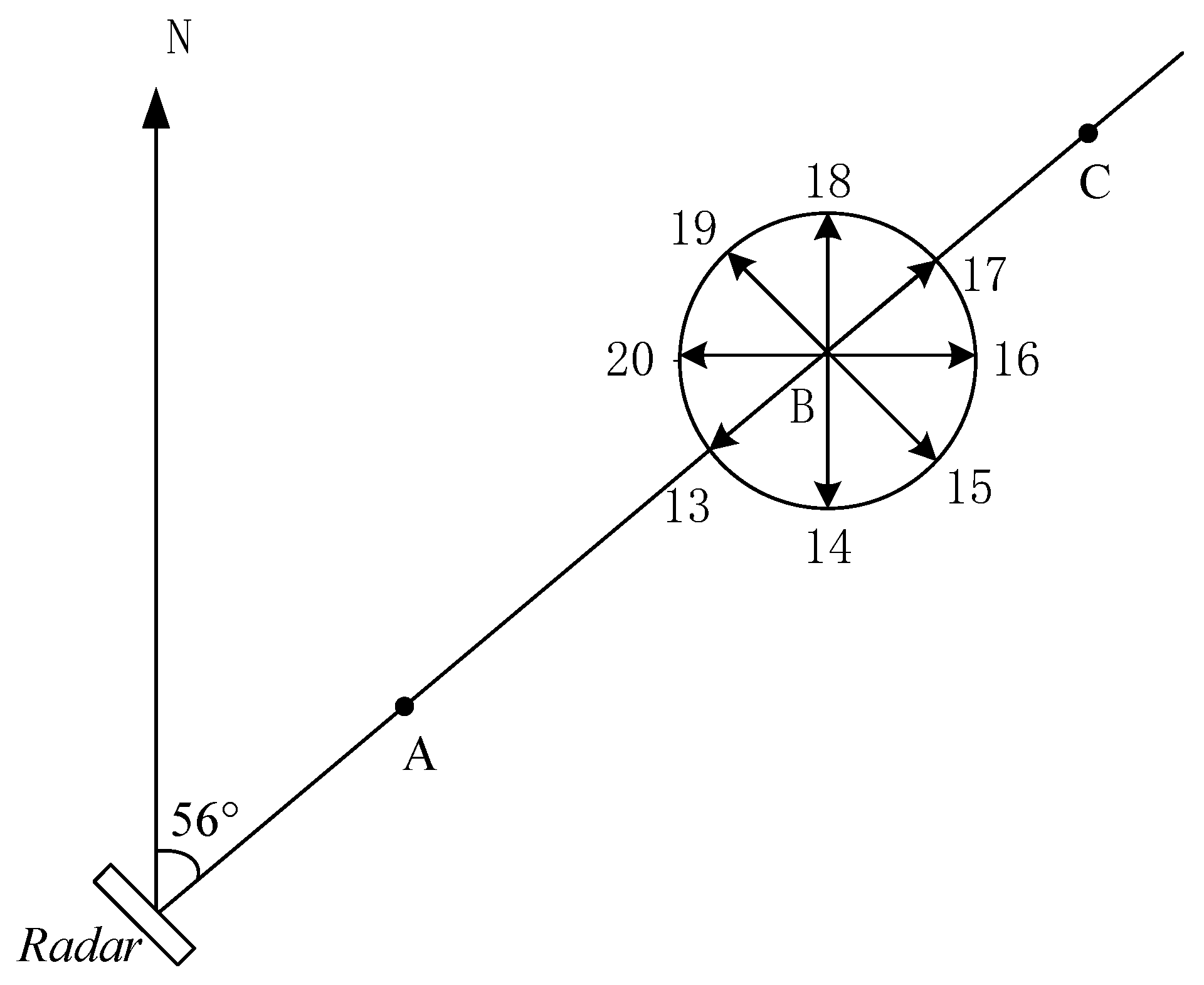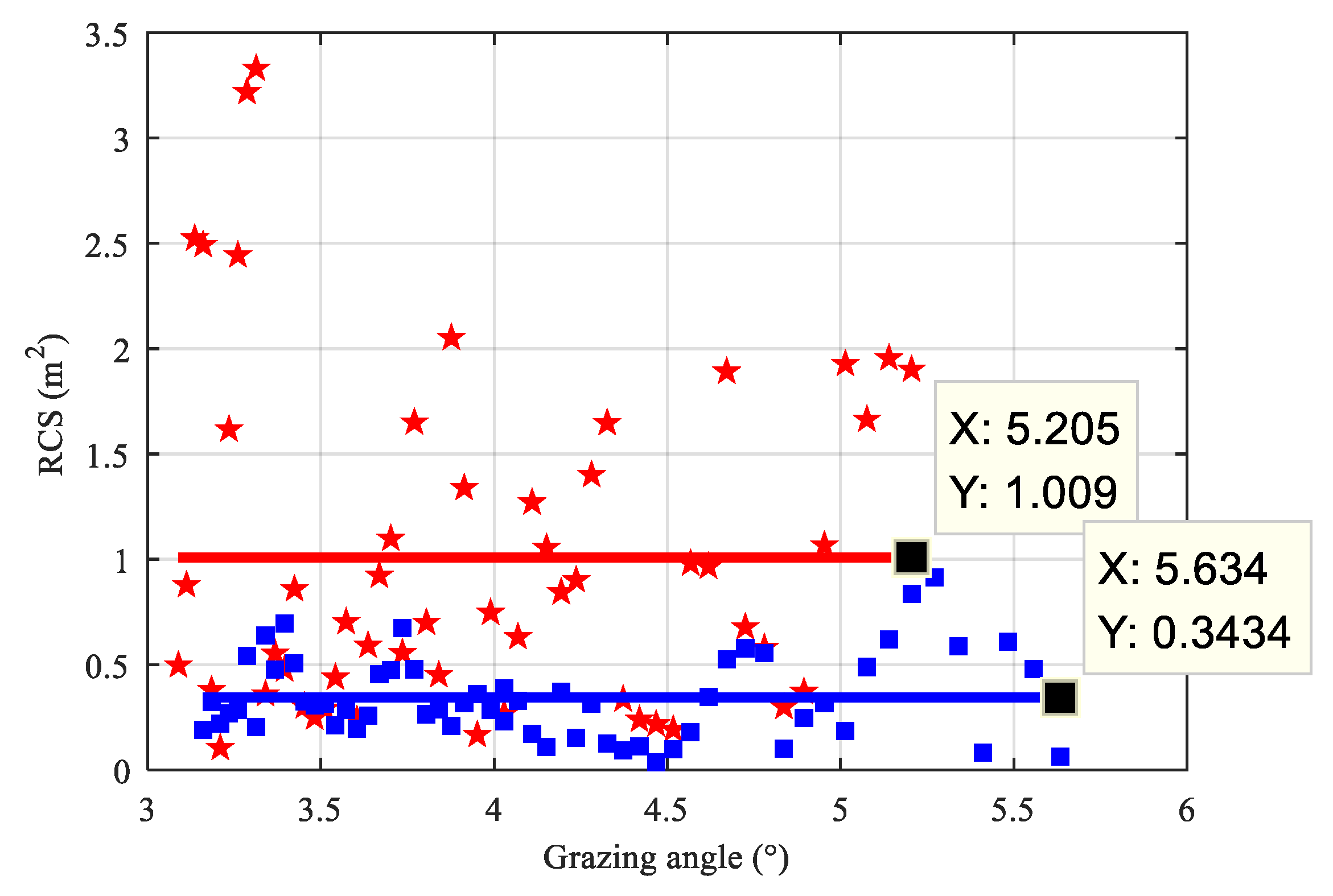RCS Measurement and Characteristic Analysis of a Sea Surface Small Target with a Shore-Based UHF-Band Radar
Abstract
:1. Introduction
2. Procedure of RCS Measurement
2.1. Overview of the Experiment
2.2. Estimation of Target RCS
3. RCS Characteristics of a Sea Surface Small Target
3.1. RCS Characteristics
3.2. Influence of Aspect Angle
3.3. Influence of Wave Condition
4. Discussion
5. Conclusions
Author Contributions
Funding
Conflicts of Interest
References
- Borkar, V.G.; Ghosh, A.; Singh, R.K.; Chourasia, N. Radar Cross-section Measurement Techniques. Def. Sci. J. 2010, 60, 204–212. [Google Scholar] [CrossRef]
- Muth, L.A. Nonlinear Calibration of Polarimetric Radar Cross Section Measurement. IEEE Antennas Propag. Mag. 2010, 52, 187–192. [Google Scholar] [CrossRef]
- Xu, X.J. New Techniques for Radar Target Scattering Signature Measurement and Processing; National Defense Industry Press: Beijing, China, 2017; pp. 6–8. [Google Scholar]
- Hua, X.; Ono, Y.; Peng, L.; Xu, Y. Unsupervised Learning Discriminative MIG Detectors in Nonhomogeneous Clutter. IEEE Trans. Commun. 2022, 70, 4107–4120. [Google Scholar] [CrossRef]
- Liu, J.; Massaro, D.; Orlando, D.; Farina, A. Radar Adaptive Detection Architectures for Heterogeneous Environments. IEEE Trans. Signal Process. 2020, 68, 4307–4319. [Google Scholar] [CrossRef]
- Skolnik, M.I. Radar Handbook, 3rd ed.; Graw-Hill: New York, NY, USA, 2008; pp. 649–655. [Google Scholar]
- Maslovskiy, A.; Legenkiy, M.; Antyufeyeva, M. BSP step for complex target RCS measuring or calculation. In Proceedings of the 9th International Kharkiv Symposium on Physics and Engineering of Microwaves, Millimeter and Submillimeter Waves (MSMW), Kharkiv, Ukraine, 20–24 June 2016. [Google Scholar]
- Maslovskiy, A.; Kolchigin, N.; Legenkiy, M.; Antyufeyeva, M. Decomposition method for complex target RCS measuring. In Proceedings of the IEEE First Ukraine Conference on Electrical and Computer Engineering (UKRCON), Kyiv, Ukraine, 29 May–2 June 2017. [Google Scholar]
- Xiao, D.H.; Guo, L.X.; Liu, W.; Hou, M.Y. Efficient RCS Prediction of the Conducting Target Based on Physics-Inspired Machine Learning and Experimental Design. IEEE Trans. Antennas Propag. 2021, 69, 2274–2289. [Google Scholar] [CrossRef]
- Sanchez-Olivares, P.; Lozano, L.; Somolinos, Á.; Cátedra, F. EM Modelling of Monostatic RCS for Different Complex Targets in the Near-Field Range: Experimental Evaluation for Traffic Applications. Electronics 2020, 9, 1890. [Google Scholar] [CrossRef]
- Fan, T.Q.; Guo, L.X.; Liu, W. A novel OpenGL-based MoM/SBR hybrid method for radiation pattern analysis of an antenna above an electrically large complicated platform. IEEE Trans. Antennas Propag. 2016, 64, 201–209. [Google Scholar] [CrossRef]
- Zhang, Q.; Wang, D.; Zhou, Y.W. A method of RCS measurement in the outfield. In Proceedings of the World Conference on Mechanical Engineering and Intelligent Manufacturing, Shanghai, China, 4–6 December 2016. [Google Scholar]
- Wei, G.Y.; Yuan, W.Z.; Gao, F.; Cui, X.H. An accurate monostatic RCS measurement method based on the extrapolation technique. In Proceedings of the IEEE 9th International Conference on Communication Software and Networks (ICCSN), Guangzhou, China, 6–8 May 2017. [Google Scholar]
- Alvarez, J. Near-Field 2-D-Lateral Scan System for RCS Measurement of Full-Scale Targets Located on the Ground. IEEE Trans. Antennas Propag. 2019, 67, 4049–4058. [Google Scholar] [CrossRef]
- He, L.W.; Xue, Z.H.; Ren, W.; Li, W.M. S-band time domain near field planar measurement for RCS inside an anechoic chamber. In Proceedings of the 2015 7th Asia-Pacific Conference on Environmental Electromagnetics (CEEM), Hangzhou, China, 4–7 November 2015. [Google Scholar]
- Chen, B.X.; Hu, T.J.; Zhu, W.; Zhang, Z.S.; Zhang, X.L. RCS measurement for scale model of stealth targets in VHF band. Chin. J. Radio Sci. 2011, 26, 480–485. [Google Scholar]
- Osipov, A.; Kobayashi, H.; Suzuki, H. An Improved Image-Based Circular Near-Field-to-Far-Field Transformation. IEEE Trans. Antennas Propag. 2013, 61, 989–993. [Google Scholar] [CrossRef]
- Schnattinger, G.; Mauermayer, R.A.M.; Eibert, T.F. Monostatic Radar Cross Section Near-Field Far-Field Transformations by Multilevel Plane-Wave Decomposition. IEEE Trans. Antennas Propag. 2014, 62, 4259–4268. [Google Scholar] [CrossRef]
- Skolnik, M.I. An empirical formula for the radar cross section of ships at grazing incidence. IEEE Trans. Aerosp. Electron. Syst. 1974, 10, 292. [Google Scholar] [CrossRef]
- Behdani, M.; Dehkhoda, P.; Tavakoli, A.; Zoofaghari, M. Modified PO-PO hybrid method for scattering of 2D ship model on the rough sea surface. IET Microw. Antennas Propag. 2019, 13, 156–162. [Google Scholar] [CrossRef]
- Liang, Y.; Guo, L.X. A Study of Composite Scattering Characteristics of Movable/Rotatable Targets and a Rough Sea Surface Using an Efficient Numerical Algorithm. IEEE Trans. Antennas Propag. 2021, 69, 4011–4019. [Google Scholar] [CrossRef]
- Yan, W.; Gen, L.; Zhou, L.; Zhao, Y.; Wang, E.R.; Zhu, D. Optimization Analysis Method on Ship RCS Based on Sea Conditions and Cubic Spline Interpolation Algorithm. J. Electron. Inf. Technol. 2018, 40, 579–586. [Google Scholar]
- Tice, T.E. An overview of radar cross section measurement techniques. IEEE Trans. Instrum. Meas. 1990, 39, 205–207. [Google Scholar] [CrossRef]
- Herselman, P.L.; Baker, C.J.; de Wind, H.J. An Analysis of X-Band Calibrated Sea Clutter and Small Boat Reflectivity at Medium-to-Low Grazing Angles. Int. J. Navig. Obs. 2008, 2008, 347518. [Google Scholar] [CrossRef]
- Brooker, G.; Lobsey, C.; Hennessy, R. Radar cross sections of small boats at 94 GHz. In Proceedings of the IEEE Radar Conference, Rome, Italy, 26–30 May 2008. [Google Scholar]
- Li, X.; Shui, P.L.; Xia, X.Y.; Zhang, J.P.; Shi, X.F. Analysis of UHF-band sea clutter reflectivity at low grazing angles in offshore waters of the Yellow Sea. Int. J. Remote Sens. 2020, 41, 7472–7485. [Google Scholar] [CrossRef]
- Li, X.; Li, H.M.; Zhang, Y.S.; Shui, P.L.; Zhang, J.P.; Xu, S.W. Calibration measurements of shore-based radar with active reflector. In Proceedings of the 12th International Symposium Antennas, Propagation, and EM Theory, Hangzhou, China, 3–6 December 2018. [Google Scholar]
- Li, X.; Shui, P.L.; Zhang, Z.D.; Zhang, Y.S.; Xu, X.W. External Calibration of P-Band Island-Based Sea Clutter Measurement Radar on sea surface. IEEE Trans. Geosci. Remote Sens. 2021, 59, 5711–5720. [Google Scholar] [CrossRef]
- Wang, C.; Tian, Y.; Yang, J.; Zhou, H.; Wen, B.; Hou, Y. A Practical Calibration Method of Linear UHF Yagi Arrays for Ship Target Detection Application. IEEE Access 2020, 8, 46472–46479. [Google Scholar] [CrossRef]
- Swerling, P. Probability of detection for fluctuating targets. IRE Trans. Inf. Theory 1960, 6, 269–308. [Google Scholar] [CrossRef]
- Swerling, P. Radar probability of detection for some additional fluctuating target cases. IEEE Trans. Aerosp. Electron. Syst. 1997, 33, 698–709. [Google Scholar] [CrossRef]







| Parameter | Value |
|---|---|
| Frequency | 456 MHz |
| Elevation angle | −4 degrees |
| PRF | 1 kHz |
| Pulse width | 10 μs (0.4 μs compressed) |
| Transmitting power | 3.2 kW |
| Antenna gain | 23 dB |
| Calibration accuracy | 2 dB |
| Data Label | Ship Route | Significant Wave Height (m) | Wave Direction (°) | Aspect Angle (°) | Grazing Angle (°) |
|---|---|---|---|---|---|
| #001 | 13→17 | 0.42 | 130.9 | 0 | 4 |
| #002 | 20→16 | 0.45 | 134.4 | 45 | 4 |
| #003 | 19→15 | 0.42 | 130.9 | 90 | 4 |
| #004 | 18→14 | 0.42 | 130.9 | 135 | 4 |
| #005 | 17→13 | 0.42 | 130.9 | 180 | 4 |
| #006 | 16→20 | 0.45 | 134.4 | 225 | 4 |
| #007 | 15→19 | 0.42 | 130.9 | 270 | 4 |
| #008 | 14→18 | 0.42 | 130.9 | 315 | 4 |
| #101 | 17→18→…→17 | 0.45 | 134.4 | 0~360 | 4 |
| #201 | A→C | 0.28 | 118.2 | 0 | 6~3 |
| #202 | A→C | 0.48 | 165.5 | 0 | 6~3 |
| Data Label | Aspect Angle (°) | Correlation Time (s) | Parameter k |
|---|---|---|---|
| #001 | 0 | 0.72 | 1.4 |
| #002 | 45 | 1.05 | 0.9 |
| #003 | 90 | 1.51 | 0.7 |
| #004 | 135 | 1.30 | 1.1 |
| #005 | 180 | 2.07 | 0.9 |
| #006 | 225 | 0.60 | 1.4 |
| #007 | 270 | 1.32 | 1.0 |
| #008 | 315 | 0.91 | 1.0 |
| Parameter | #201 | #202 |
|---|---|---|
| Correlation time | 5.70 s | 6.03 s |
| Parameter k | 0.8 | 1.1 |
| 1.05 m2 | 0.34 m2 | |
| 0.66 m2 | 0.25 m2 | |
| 7.56 m2 | 2.97 m2 | |
| 0 m2 | 0 m2 | |
| S | 1.06 m2 | 0.32 m2 |
| V | 1.01 | 0.92 |
Publisher’s Note: MDPI stays neutral with regard to jurisdictional claims in published maps and institutional affiliations. |
© 2022 by the authors. Licensee MDPI, Basel, Switzerland. This article is an open access article distributed under the terms and conditions of the Creative Commons Attribution (CC BY) license (https://creativecommons.org/licenses/by/4.0/).
Share and Cite
Xia, X.; Li, X.; Shui, P.; Zhang, Y.; Li, Q. RCS Measurement and Characteristic Analysis of a Sea Surface Small Target with a Shore-Based UHF-Band Radar. Electronics 2022, 11, 2573. https://doi.org/10.3390/electronics11162573
Xia X, Li X, Shui P, Zhang Y, Li Q. RCS Measurement and Characteristic Analysis of a Sea Surface Small Target with a Shore-Based UHF-Band Radar. Electronics. 2022; 11(16):2573. https://doi.org/10.3390/electronics11162573
Chicago/Turabian StyleXia, Xiaoyun, Xin Li, Penglang Shui, Yushi Zhang, and Qingliang Li. 2022. "RCS Measurement and Characteristic Analysis of a Sea Surface Small Target with a Shore-Based UHF-Band Radar" Electronics 11, no. 16: 2573. https://doi.org/10.3390/electronics11162573






